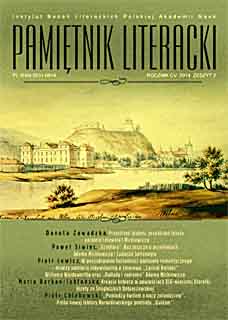Z jakiego wydania „Cherubinowego wędrowca” korzystał Mickiewicz?
Which Edition of “Cherubinischer Wandersmann” (“The Cherubinic Pilgrim”) Did Mickiewicz Use?
Author(s): Andrzej LamSubject(s): Literary Texts
Published by: Instytut Badań Literackich Polskiej Akademii Nauk
Keywords: Adam Mickiewicz; Angelus Silesius; Johannes Scheffler; “Cherubinischer Wandersmann [The Cherubinic Pilgrim]”; Mickiewicz's “Zdania i uwagi [Thoughts and Remarks]”; Gottfried Arnold; Saint-Martin; Franz Baader; Jakob Böhme
Summary/Abstract: The question about Mickiewicz’s reading of epigrams by Angelus Silesius (Johannes Scheffler) from the collection “Cherubinischer Wandersmann [The Cherubinic Pilgrim]” has many times been posed but no convincing answer has been supplied. It was known that Mickiewicz raised his interest in the Breslau poet in 1833 or even earlier, possibly before leaving for Paris. Between 1833–1836 he produced epigrams inspired by mystical writings by Saint-Martin, Franz Baader, Jakob Böhme and Angelus Silesius which the poet entitled “Zdania i uwagi [Thoughts and Remarks]”. As a motto to the collection Mickiewicz used in his manuscript was the only in German epigram by Angelus: “Ruh ist das höchste Gut: und wäre Gott nicht ruh / Ich schlösse vor Ihm selbst mein’ Augen beide zu” (I 49), which is different from the 1675 copy of the last hand edition, where the second line is “Jch schliesse für Jhm selbst mein’ Augen beide zu.” The above disparity forms a starting point for further research consisting in analyses of the multiplied from the second decade of 19th c. editions of Silesius’ texts in which Mickiewicz might arose his interest. In those circumstances, the first complete edition of “The Cherubinic Pilgrim” was issued in 1827 in Munich. The analysis of the text revealed that its basis was the last 18th republication of the text (from 1737) which, in turn, was an adaptation of Gottfried Arnold’s edition (1701, 1713), the basis of which was last hand edition. The condition of an anonymous editor from 1829 – Sulzbach, Seidel’sche Buchhandlung – was different. He possessed a rare copy of a Vienna editio princeps (containing five of the ultimate six books) and Arnold’s 1701 edition and, qualified in philology, he prepared out of the two sources an almost ideal account. And it is here, and only here, that we find the epigram (I 49) in the version adopted by Mickiewicz, thus we can be certain that it was that copy that the author of “Thoughts and Remarks” possessed.
Journal: Pamiętnik Literacki. Czasopismo kwartalne poświęcone historii i krytyce literatury polskiej
- Issue Year: 2014
- Issue No: 2
- Page Range: 151-157
- Page Count: 7
- Language: Polish

